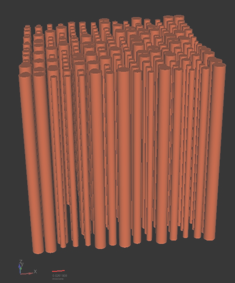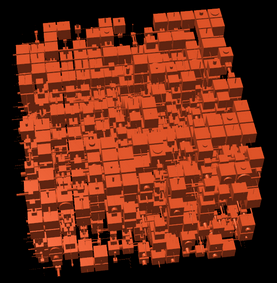Here are the questions we are asked most often. The FAQ section of the website may be more up to date than the printed / pdf version of the User Manual. If you cannot find your answer here, please ask us.
How accurate is your model?
A lot more accurate than most approximations in the current research literature, as demonstrated in our validation exercises. However, you need to appreciate the scientific basis of the model, as described in the Welcome section.
What type of samples can you model?
The scope of the model is also described in the Welcome section.
Can I use permeability or hydraulic conductivity data to derive a void structure?
No. Permeability or hydraulic conductivity is too sensitive to too many features of the void structure, so inverse modelling of that property is not possible. Also, a single permeability or hydraulic conductivity reading contains too little information. A single measurement from the mercury intrusion curve (e.g. the characteristic throat diameter) also provides too little information, which is why PoreXpert uses the shape of the entire curve.
Can PoreXpert read data files direct from my porosimeter or porometer?
Yes. PoreXpert reads data direct from Micromeritics Autopore, ThermoFisher (Carlo Erba) Pascal, Quantachrome porosimeters and the PoroluxTM 100 or 1000 Porometer. For further details on file formats, see Experimental File Formats in this Help system.
Can I use ThermoFisher mercury porosimetry data that has been corrected for compressibility?
PoreXpert can read Thermo Fisher data that have been corrected for compressibility and uncorrected data from the SOLID software. If you want to use compressibility corrected data from SOLID you need to export the data using the Export to PoreXpert button on the Export Tab. Older versions of SOLID do not have this feature.
Why do I need PoreXpert when I already have the Manufacturer's porosimeter software?
The Manufacturer's software uses an implicit assumption that the porous solid comprises unconnected aligned hollow cylinders, as in the Not this diagram below. If your sample is like that, then use the Manufacturer's software. If it is more like the But this diagram, i.e. a 3-D interconnected network of voids and narrower connections shown as solid, with transparent solid phase, then PoreXpert will give you more information.
 |
 |
Not This |
But This |
The Micromeritics and ThermoFisher software calculates fractal dimensions, whereas PoreXpert does not. Why not?
First you need to read the previous answer. Then the answer to this is that whereas a fractal dimension can be calculated based on the aligned cylinders model, it is very much more difficult for a 3-D interconnected network, and we have not done it yet.
Can I use PoreXpert for quality assurance purposes?
Yes. Imagine a box bounded by acceptable upper and lower limits of two experimental parameters. The box is two-dimensional for 2 parameters, but for more parameters becomes a cuboid, and so on. If your product's properties fall within the box, then it is acceptable for sale. PoreXpert allows you to use more and/or better parameters to define the box. For example, you could replace characteristics throat diameter, which is based on the 50% intrusion point, with simulated permeability, which may be much closer to a required experimental property. In practice, we use a multivariate analysis package to statistically analyse the data, and look for correlation clusters. We have done this for tantalum capacitors made from sintered tantalum corals - the efficiency of the final capacitors correlated closely with PoreXpert simulated permeability.
While working with PoreXpert program, an error occurred with a data file. Error message was like 'second data is lower than first data'?
The software will not accept intrusion curves for which the intrusion volume goes down with increasing pressure. First check that you have followed our experimental protocols for mercury porosimetry or water retention. The problem can also occur if the user has not used the PoreXpert compressibility corrector to pre-process the data using an accurate blank run for the same penetrometer. So under those circumstances, you must clean up the data file - i.e. remove the values which go down instead of up.
Can I model both mercury intrusion and extrusion, or both water retention and drainage?
No - unfortunately PoreXpert only fits itself to a mercury intrusion curve, water retention curve or porometry data. We have not managed to fit both intrusion and extrusion (percolation and imbibition) together yet (or water retention followed by drainage). However, we have modelled the pressure-cyclic mercury porosimetry of nuclear graphite (Laudone et al., 2014).
The PoreXpert program did not get a value of porosity from Micromeritics *.rpt, or Quantachrome *.prm file. I read it from a report and wrote it in the data input screen. Is this operation valid?
Yes - for Micromeritics and Quantachrome format files the software does not read the porosity directly, so must be input manually. However, if the intrusion files and the blank are processed first using the compressibility corrector for Micromeritics files, the correct porosity is calculated.
Can I find the porosity of my sample by using PoreXpert ?
No - porosity is an input to the inverse modeller, not an output. Porosity needs to be measured experimentally.